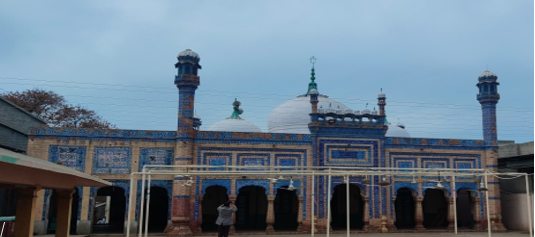A Sacred Journey through Time: Documenting Aesthetics, Material Decay, and Preservation Needs of Jamia Masjid Akbaria
Abstract
 Abstract Views: 0
Abstract Views: 0
Masjid Akbaria, a magnificent mosque in Multan, Pakistan is renowned for its remarkable historical architecture and deep cultural significance. Constructed in the 20th century, it stands as a testament to the grandeur and artistic excellence of the British era. The mosque's intricate details, including delicate calligraphy, vibrant frescoes, and sophisticated structural elements, contribute to its historical and architectural significance. The current research examined the historical background, architectural features, and significance of the Masjid Akbaria's architectural style. Moreover, it underscored the value of mosque's elements and its magnificent design, incorporating documentation and aesthetic evaluation to support its preservation. Additionally, the study highlighted the crucial role of both local communities and governmental bodies in protecting this cultural heritage site. By blending traditional preservation techniques with contemporary conservation methods, it presented a comprehensive approach to restoring the mosque, ensuring its enduring function as a spiritual and cultural landmark.
Downloads
References
Ahmad, A. G. (1999, January 30–3 February). The architectural styles of mosques in Malaysia: From vernacular to modern structures [Paper presentation]. Proceedings of the symposium on Mosque architecture: The historic and urban developments of Mosque architecture, Riyadh, Saudi Arabia.
Al-Faruqi, I. R., & Al-Faruqi, L. L. (1986). The cultural atlas of Islam. Macmillan.
Bloom, J. M. (2001). Creswell and the origins of the minaret. Muqarnas, 8, 55–65.
Creswell, K. A. C. (1926). The evolution of the minaret with special reference to Egypt. Burlington Magazine, 48(277), 134–140.
Fletcher, B., & Fletcher, B. F. (1905). A history of architecture on the comparative method for the student, craftsman, and amateur (5th ed.). Batsford Books.
Frishman, M., & Khan, H.-U. (Eds.). (2007). The mosque: History, architectural development & regional diversity. Thames & Hudson.
Hashim, D. M. (2005). Indian and Mogul influences on mosques. In V. F. Chen (Ed.), The encyclopedia of Malaysia: Architecture (Vol. 5, pp. 84–85). Archipelago Press.
Hillenbrand, R. (2000). Islamic architecture: Form, function and meaning. Edinburgh University Press.
Ismail, A. S. (2008). The influence of Islamic political ideology on the design of state mosques in West Malaysia (1957–2003) [Doctoral dissertation, Queensland University of Technology]. QUT ePrints. https://eprints.qut.edu.au/19371/
Johns, J. (1999). The “House of the Prophet” and the concept of the mosque. In J. Johns (Ed.), Bayt Al-Maqdis: Jerusalem and early Islam (pp. 59–72). Oxford University Press.
Johnson, P. (1979). Civilizations of the Holy land. Weidenfeld and Nicolson.
Khan, H. U. (1990). The architecture of the mosque: An overview and design directions. In H. Salam (Ed.), Expressions of Islam in buildings (pp. 109–127). Concept Media.
Michell, G. (Ed.). (2006). Architecture of the Islamic world. Thames & Hudson.
Nasir, A. H. (1984). Masjid-masjid di Semenanjung Malaysia. Berita Publishing.
Norberg-Schulz, C. (1986, April 21–25). The architecture of unity [Paper presentation]. Proceedings of Seminar Ten in the series of Architectural Transformations in the Islamic World, Granada, Spain.
Rasdi, M. T. H. M. (2000). The architectural heritage of the Malay world: The traditional mosque. Penerbit Universiti Teknologi Malaysia.
Rasdi, M. T. M. (2007). Mosque architecture in Malaysia: Classification of styles and possible influence. Jurnal Alam Bina, 9(3), 1–37.
Salahuddin, S., Chauhan, M. K., Bhatti, O. S., & Mujahid, S. (2024). Regional Progression Gardens of Lahore in Context of Design & Open Spaces with Historical Timeline: Pre and Post Partition Abstract. Journal of Historical Studies, X, 288-310.
Urey, O. (2013). Transformation of minarets in contemporary mosque architecture in Turkey. International Journal of Sport Culture and Science, 1(4), 95–107.
Yeang, K. (1992). The architecture of Malaysia. The Pepin Press.

Copyright (c) 2025 Muhammad Naeem Khalid, Jahanzaib Qamar, Tariq Mahmood

This work is licensed under a Creative Commons Attribution 4.0 International License.
JAABE follows an open-access publishing policy and full text of all published articles is available free, immediately upon publication of an issue. The journal’s contents are published and distributed under the terms of the Creative Commons Attribution 4.0 International (CC-BY 4.0) license. Thus, the work submitted to the journal implies that it is original, unpublished work of the authors (neither published previously nor accepted/under consideration for publication elsewhere). On acceptance of a manuscript for publication, a corresponding author on the behalf of all co-authors of the manuscript will sign and submit a completed Copyright and Author Consent Form.
Copyright (c) The Authors





